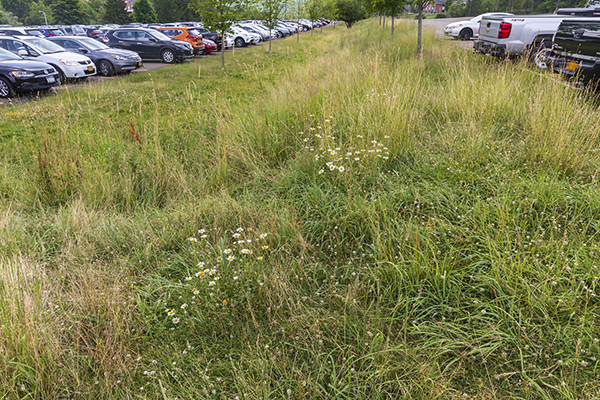Campus implements low-mow conversion plan
Some areas of campus to be mowed only once a year

As part of the University’s sustainability efforts, the campus this summer began implementing a low-mow conversion plan that designates some areas for mowing only once per year. Grassy spaces around the M lots and a steep embankment adjacent to the East Gym parking lot are included in the first phase of the plan, where grass is being allowed to feather out to its full length.
This new, low-maintenance regime will result in a number of benefits for the campus, according to Nick Corcoran, campus landscape architect.
“The low-mow plan will help us decrease fossil fuel consumption, increase biodiversity and drought tolerance, and also improve storm water filtration,” he said. “Limiting mowing will also free up grounds crew members so they can focus on maintenance of other areas of campus.”
The plan is a departure from the current campus standard of weekly mowing all grass on campus, weather permitting. “Although this level of maintenance seems appropriate in high-visibility areas such as the main entrance to campus and functional spaces like the Peace Quad and residential community open spaces, it is a waste of fuel and labor in areas that are less trafficked by visitors or not used as programmable space,” Corcoran said.
The low-mow plan originated from two efforts that were initially developing separately. Physical Facilities was at work on a landscaping master plan while, concurrently, the campus Sustainability Committee was exploring ways to increase sustainability efforts.
Areas for possible conversion to low-mow were surveyed earlier in the year and the plan was presented to several groups on campus including the Committee on University Environment (CUE), Residential Life and the Campus Appearance Task Force.
Low-mow areas will be converted in phases to experiment with various methods of maintenance. During the initial, trial phase, existing grass will simply be mowed once per year, with signage posted to explain the practice.
In subsequent years, low-mow areas may be phased over to a no-mow seed mix, such as a drought-tolerant fescue mix, which is better suited to low-level maintenance, or converted to no-mow meadows that provide additional ecosystem components, create a backdrop of natural beauty and provide opportunities for student research.
Conversion areas will have fully manicured lawns around the edges to help define the limits and create a buffer between pedestrian and vehicle traffic and the low-mow areas, said Corcoran.
Low-mow areas are often recognized and measured by organizations such as The Association for the Advancement of Sustainability for Higher Education. SUNY Fredonia, Cornell University, St. Lawrence University and Middlebury College are among other higher-e
